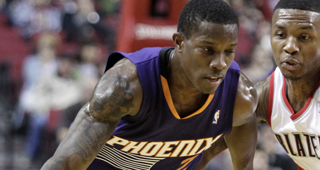We’re now two months into the NBA season, and some players who we thought we already knew are either mushrooming to heights previously unseen or, sadly and slowly, declining. One example of the former is Eric Bledsoe, a second-tier point guard who’s always had the physical gifts necessary for greater things.
Any celebration of Bledsoe’s growth has been squandered by an aimless, eternally frustrating iteration of the Phoenix Suns. But, aside from the past two games, mini-LeBron is off to the best season of his career. By far.
In a world where Kobe Bryant doesn’t get voted into the All-Star game (aka a different world than the one we live in), Bledsoe is more than deserving of a reserve spot. He’s a top-five point guard by almost any measure, and right now his body of work is equal if not better better than that which has been cobbled together by John Wall, Chris Paul and Damian Lillard.
Long a bowling ball made of cement and silly putty, Bledsoe can stop on a dime, shift direction and spontaneously swivel at dangerously high speeds—as if under command by a remote control—but the refined optics behind his ongoing evolution upstage even the most exceptional statistics.
The 26-year-old has never looked so relaxed on a basketball court. He no longer has to flex his muscles every time he has the ball. Instead, in his sixth season and third as a starter, it’s more of a mind game, with pick-and-roll ingenuity, crafty passing and smart reactions to the defense’s scheme. Bledsoe has never looked more lucid at the helm.
His usage percentage is at a career high while his turnover rate is an all-time low. Coming off a stagnant season that depressed any idea of Bledsoe somehow emerging into the forefront of a crowded point guard position, the 26-year-old is blooming for the second time in three seasons.
He’s averaging nearly five more points per game, in part because his shot has never been more potent. In the shadow of Stephen Curry’s MVP season, the pull-up three has emerged as the most devastating weapon any ball-dominant player can have. Last year, Bledsoe shot 33.9 percent on pull-up threes, and attempted 1.5 per game. This season his volume and accuracy are both up. Coming into the week, he was launching 2.5 pull-up threes per game and making 42 percent of them, per SportVU.
Almost all are uncontested, a strategic play by opponents who figure the law of averages will force a regression sooner than later. And over the past few games they’ve been right. But, for the most part, shots are falling.
The mid-range jumper, long a necessary companion for any pick-and-roll maestro, has become Bledsoe’s friend. He’s neither attempted nor made more shots from that area than he is right now. And of the 57 players who’ve used at least 100 possessions running a pick-and-roll, only Curry, DeMar DeRozan and Tony Parker are more efficient.
But none of this is to suggest the guy is settling. He’s fearlessly hand-picking his spots and making opponents pay. Bledsoe goes back and forth with Detroit’s Reggie Jackson for the league lead in drives per game, and only five players have used more possessions in transition, per Synergy Sports. The Suns go from the fastest team in the league when he’s on the court to seventh fastest when he’s off (they’re never slower than when Bledsoe’s on the bench).
Phoenix’s high pace gives his numbers a boost, and the supporting cast is warmer to his skill-set than it was a season ago. That context matters, and sometimes a player’s surrounding environment has as much to do with his progress as the thousands of lonely hours spent in an empty gym. Bledsoe’s improvement appears to be a blend of both and all of it’s wonderful news for a player who’s currently fourth in RPM among point guards.
But not all is rosy. Unlike other elite point guards, the Suns don’t see much of a drop off on offense when Bledsoe isn’t on the floor, despite the fact that Ronnie Price is his backup. That’s a red flag. Furthermore, only three players have more turnovers, and his defense is, well, really bad.
Athletically, Phoenix’s best player can stay in front of any ball-handler in the world. He’s strong, has tremendous instincts and makes an effort to fight through screens to stick with his man. He’s versatile, too, and can size up both backcourt positions. But when Bledsoe’s man doesn’t have the ball, it’s an epic nightmare of confusion and half-hearted effort.
No player is better evidence of how unreliable “steals” are as a metric. Bledsoe’s 63 are third in the league, but his constant gambling negates any positive impact.
Exhibit A:

Exhibit B (a truly strange play where Bledsoe leaves his man—Randy Foye, a career 37 percent three-point shooter—all alone and then teams up with Brandon Knight to commit one of the strangest brain farts you’ll ever see):

These are terrible possessions and there are dozens more just like them. Off-ball naps aren’t new to Bledsoe’s game, and for him to shed the remnants of a “he’s pretty good, but not great” reputation, his team needs to win and he needs to clean up perfectly correctable mistakes. Staying awake as a help defender is one way to kill two birds with one stone.
There’s more than enough time to solidify the mushy parts of his game, and even those shouldn’t obscure just how impressive he’s been everywhere else. Bledsoe is an all-around force with the ball in his hands, someone who makes teammates better and has learned when and how to opt for the complicated pass over the simple one.
It’s all a work in progress, but the leap he’s already made is magnificent by itself.



